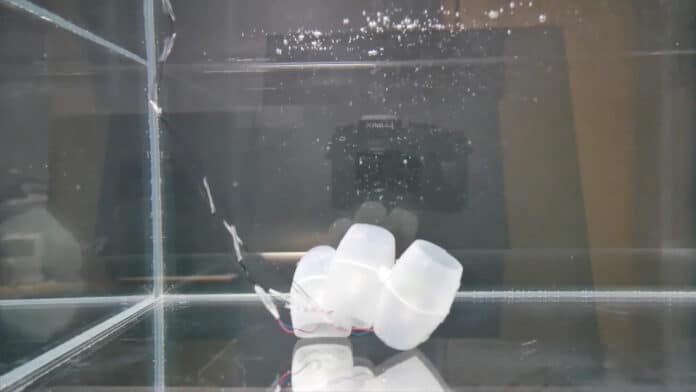Researchers from the University of Bristol have developed an underwater robot called RoboSalps, designed to operate in unknown and extreme environments such as extra-terrestrial oceans.
The robot is inspired by the design and life of mysterious zooplankton. Despite looking a bit like jellyfish, salps belong to the family of Tunicata, a group of animals also known as sea squirts. They have a complex life cycle, changing between solitary and aggregate generations, where they connect to form colonies.
Salps’ semi-transparent barrel-shaped bodies inspired the tubular bodies of Bristol’s RoboSalps. The robot can link to each other to form ‘colonies,’ which gives them new capabilities that can only be achieved because they work together.
“RoboSalp is the first modular salp-inspired robot. Each module is made of a very light-weight soft tubular structure and a drone propeller which enables them to swim,” said researcher Valentina Lo Gatto of Bristol’s Department of Aerospace Engineering is leading the study. “These simple modules can be combined into ‘colonies’ that are much more robust and have the potential to carry out complex tasks. Because of their low weight and their robustness, they are ideal for extra-terrestrial underwater exploration missions, for example, in the subsurface ocean on the Jupiter moon Europa.”
RoboSalps’ each individual module can swim on its own thanks to a small motor with rotor blades inserted into the soft tubular structure. When swimming on their own, RoboSalps modules are difficult to control, but after joining them together to form colonies, they become more stable and show sophisticated movements.
The underwater robots are soft, potentially quite energy efficient, and robust due to inherent redundancy. This makes them ideal for autonomous missions where direct and immediate human control might not be feasible.
According to the team, the relatively novel concept of a soft robot colony has a wide range of interesting applications. These include the exploration of remote submarine environments, sewage tunnels, and industrial cooling systems. It could split into multiple segments, each exploring in a different direction, and afterward, reassemble in a new configuration to achieve a different objective, such as manipulation or sample collection.
The research team is looking even further into the future and sees the use of RoboSalps in extra-terrestrial missions as well. Its compliant body also provides safer interaction with potentially delicate ecosystems, reducing the risk of environmental damage. In addition, these robots can easily be stored in a reduced volume, which is ideal for reducing global space mission payloads.
“We are also developing control approaches that are able to exploit the compliance of the modules with the goal of achieving energy-efficient movements close to those observed in biological salps,” Prof Jonathan Rossiter added.
